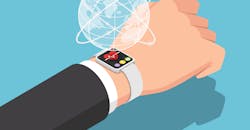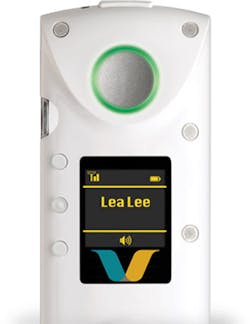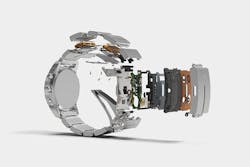Download this article in PDF format.
Wireless telephone users may feel naked walking out of the house without their cell phones. But the day is drawing near where the cell phone may be joined by other wireless devices on a person, as dependence on wireless technology grows for communication, location, and even healthcare. Wearable wireless devices are increasingly combining function with fashion—a trend that’s expected to continue with the emergence of support from 5G wireless networks.
The earliest wearable wireless devices have typically been some form of radio-frequency identification (RFID) tag that have been used to keep track of small children and pets, or elderly users in need of special monitoring or medical requirements. Another form of short-range wireless technology, such as Bluetooth, is often combined on the same monitoring device for additional communications capabilities. Products such as audio hearing aids and headphones have been available for some time with some form of short-range wireless technology, to free users from the entanglement of wired connections.
Market Drivers
The strong current market growth in wearable wireless devices centers around “smart watches” and the increasing use of wireless technology for electronic devices that keep users informed in some way, such as medical-monitoring and healthcare-tracking functions. As with cell phones, the earliest smart watches have been bulky, attempting to cram as much wireless transceiver electronics as possible into the small volume of a wristwatch to enable some form of wireless near-field communication (NFC), such as Bluetooth or Wi-Fi.
Much credit, of course, is due to Apple Inc. and the clever marketing of its Apple Watch “smart watches” (now available in Series 4 products). They pack NFC capabilities and supporting displays into a compact, watch-sized device that’s as wearable as a conventional time-keeping watch. The Apple Watches build on the popularity of the company’s iPhone cell phones and their multifunctional capabilities. Apple Watches (Fig. 1), like other wearable wireless devices, make use of available wireless bands typically reserved for short-range wireless communications, such as the 2.4- and 5.0-GHz Wi-Fi frequency bands and Bluetooth Low Energy (BLE) bands.
1. This third-generation iWatch wireless watch features a vivid graphics display within an electronics-packed housing. (Courtesy of Apple Inc.)
As mentioned, like early cellular communications products, early wireless watches were accused of being oversized (at least compared to conventional watches) in attempts to squeeze as much RF and signal-processing electronics as possible into small packages that were also light enough to be worn without noticing. The antenna is a key component that’s not easy to miniaturize, especially at lower frequencies with their longer wavelengths. This has prompted designers of wearable wireless devices such as smart watches to explore the use of antennas built into the fabric of watch wristbands or even the use of higher, millimeter-wave frequencies and their shorter wavelengths to enable the use of smaller antennas.
The success of early developers such as Apple with its smart watches has spurred a virtual explosion in the development of wearable wireless devices for applications such as medical alerts, general healthcare and fitness, and even pet-location monitoring. Implantable healthcare sensors are being used as part of body-area networks (BANs) to provide doctors and other healthcare providers with almost instant access via a wireless mobile device to a critical parameter of a patient’s health, such as blood pressure, heart rate, or pulse rate.
NFC between patients and healthcare providers can be supported by wearable wireless devices in various forms, including pendants and badges typically operating within wireless-local-area-network (WLAN) frequency bands at 2.4 and 5.0 GHz. Wireless devices designed for medical BAN communication systems and medical telemetry also make use of the Wireless Medical Telemetry Service (WMTS) bands within 608 to 614 MHz, 1395 to 1400 MHz, and 1427 to 1432 MHz, as well as the Medical Implant Communication Services (MICS) band from 402 to 405 MHz set aside by the FCC for such purposes.
2. Healthcare monitoring and reporting are of growing importance for wearables such as this compact communications badge operating within the Wi-Fi band. (Courtesy of Vocera)
As with other wireless electronic products, wearables are being designed to fit smaller, lighter packages with as much capability as possible. As an example, the B3000n Communications Badge (Fig. 2) from Vocera is designed for medical monitoring within the Wi-Fi frequency bands from 2400 to 2484 MHz and 5180 to 5805 MHz, supporting data rates from 1 to 54 Mb/s within those bands. It’s constructed for simple operation by multiple users—it can be passed along by factory or medical workers from shift to shift for ease of short-distance communications regarding manufacturing processes or patient conditions, respectively. The wireless badge, including its lithium-ion-polymer rechargeable battery, weighs less than 2 oz. It employs direct sequence spread spectrum (DSSS) and orthogonal frequency division multiplexing (OFDM) within the Wi-Fi bands to avoid interference with existing Wi-Fi communications.
Showing Style
One major electronics manufacturer taking a different look at wearable wireless devices, Sony Corp., developed a “not so smart” wireless watch that it calls Wena. It takes a departure from the traditional electronics-packed housing and passive wristband by using a traditional analog face and cramming the radio and signal-processing electronics into the wristband (Fig. 3).
3. The Wena wireless watch is constructed with the electronic components within the wristband rather than the watch housing. (Courtesy of Sony Corp.)
The Wena was developed as part of an internal product development program in which employees were encouraged to design and develop a smart watch that would have much greater appeal than the company’s earlier wireless watches. The watch name is an acronym for “Wear Electronics Naturally,” since the smart watch was designed to appeal to those who felt that smart watches with graphics-loaded displays may be too much of a compromise fashion-wise when attending meetings requiring a more serious tone.
Coupled with the growing use of wearables will be the increasing importance of some way to easily provide power to those rechargeable devices. Solutions will likely come in the form of wireless charging or energy-harvesting technology. Wireless charging, by which an RF/microwave receiver transforms high-frequency signals from a local transmitter base station to energy for a nearby rechargeable battery, will be especially critical for implanted wireless medical devices. But it’s also being viewed by many commercial businesses, such as drive-through restaurants, as a means of attracting customers with rechargeable cell phones and wearable wireless devices who might be at “low energy levels” in more ways than one!
About the Author
Jack Browne
Technical Contributor
Jack Browne, Technical Contributor, has worked in technical publishing for over 30 years. He managed the content and production of three technical journals while at the American Institute of Physics, including Medical Physics and the Journal of Vacuum Science & Technology. He has been a Publisher and Editor for Penton Media, started the firm’s Wireless Symposium & Exhibition trade show in 1993, and currently serves as Technical Contributor for that company's Microwaves & RF magazine. Browne, who holds a BS in Mathematics from City College of New York and BA degrees in English and Philosophy from Fordham University, is a member of the IEEE.




